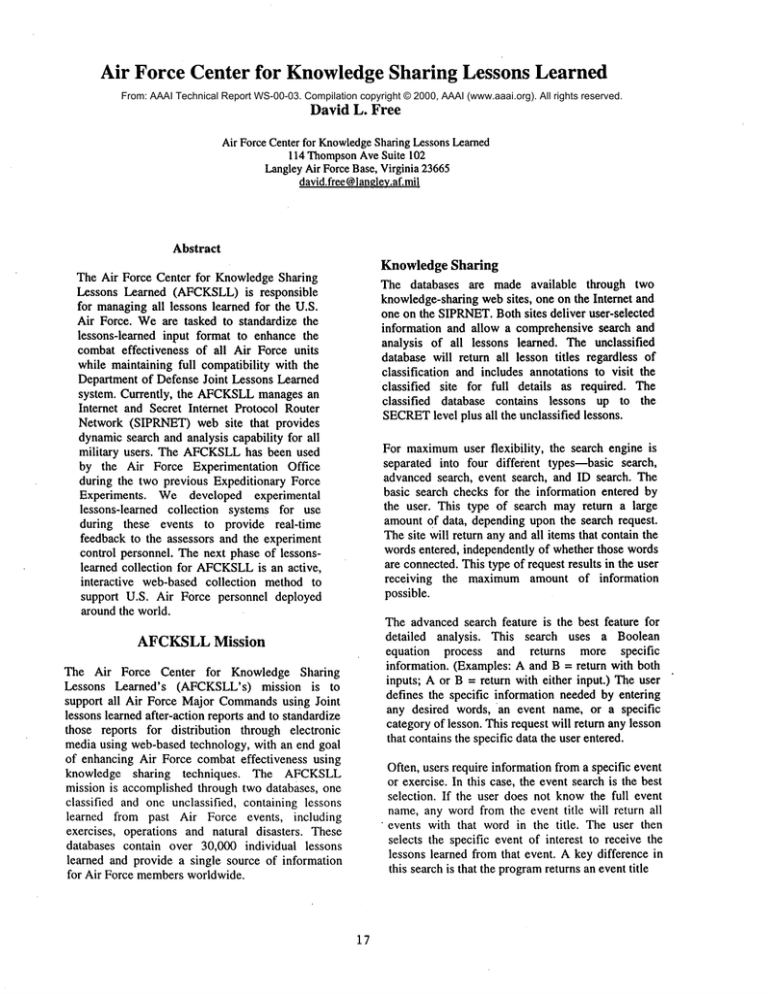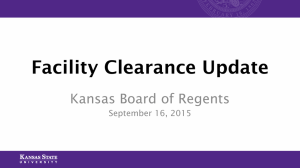
Air Force Center for KnowledgeSharing Lessons Learned
From: AAAI Technical Report WS-00-03. Compilation copyright © 2000, AAAI (www.aaai.org). All rights reserved.
David L. Free
Air Force Center for Knowledge
Sharing LessonsLearned
114 Thompson
Ave Suite 102
LangleyAir ForceBase, Virginia 23665
david.free @langley.af.mil
Abstract
Knowledge Sharing
The databases are made available through two
knowledge-sharingweb sites, one on the Internet and
one on the SIPRNET.
Both sites deliver user-selected
information and allow a comprehensivesearch and
analysis of all lessons learned. The unclassified
database will return all lesson titles regardless of
classification and includes annotations to visit the
classified site for full details as required. The
classified database contains lessons up to the
SECRET
level plus all the unclassified lessons.
The Air Force Center for KnowledgeSharing
Lessons Learned (AFCKSLL)is responsible
for managingall lessons learned for the U.S.
Air Force. Weare tasked to standardize the
lessons-learned input format to enhance the
combat effectiveness of all Air Force units
while maintaining full compatibility with the
Department of Defense Joint Lessons Learned
system. Currently, the AFCKSLL
manages an
Internet and Secret Internet Protocol Router
Network (SIPRNET) web site that provides
dynamicsearch and analysis capability for all
military users. The AFCKSLL
has been used
by the Air Force Experimentation Office
during the two previous Expeditionary Force
Experiments. We developed experimental
lessons-learned collection systems for use
during these events to provide real-time
feedback to the assessors and the experiment
control personnel, The next phase of lessonslearned collection for AFCKSLL
is an active,
interactive web-based collection method to
support U.S. Air Force personnel deployed
around the world.
For maximum
user flexibility,
the search engine is
separated into four diffet~ent types--basic search,
advanced search, event search, and ID search. The
basic search checks for the information entered by
the user. This type of search may return a large
amountof data, depending upon the search request.
The site Will return any and all items that contain the
words entered, independently of whether those words
are connected. This type of request results in the user
receiving the maximumamount of information
possible.
The advanced search feature is the best feature for
detailed analysis. This search uses a Boolean
equation process and returns more specific
information. (Examples: A and B = return with both
inputs; A or B = return with either input.) The user
defines the specific information needed by entering
any desired words, an event name, or a specific
category of lesson. This request will return any lesson
that contains the specific data the user entered.
AFCKSLLMission
The Air Force Center for Knowledge Sharing
Lessons Learned’s (AFCKSLL’s) mission is
support all Air Force Major Commandsusing Joint
lessons learned after-action reports and to standardize
those reports for distribution through electronic
media using web-based technology, with an end goal
of enhancing Air Force combat effectiveness using
knowledge sharing techniques.
The AFCKSLL
mission is accomplished through two databases, one
classified and one unclassified, containing lessons
learned from past Air Force events, including
exercises, operations and natural disasters. These
databases contain over 30,000 individual lessons
learned and provide a single source of information
for Air Force membersworldwide.
Often, users require information from a specific event
or exercise. In this case, the event search is the best
selection. If the user does not knowthe full event
name, any word from the event title will return all
"events with that word in the title. The user then
selects the specific event of interest to receive the
lessons learned from that event. A key difference in
this search is that the programreturns an event title
17
listing first, rather than the individual lessons learned
returned by the other search types. As an example,
the Air Force may hold manyBlue Flag exercises per
year. A user could enter "Blue Flag" in the event
name and receive all Blue Flag exercise reports by
title and designation number; i.e., Blue Flag 98-4.
Then, by selecting the specific report, the user will
receive only the lessons fromthat specific event.
Experimentation
AFCKSLL
developers created an active, lessonslearned management web site to support the Air
Force Experimentation Office during Expeditionary
Force Experiments 1998 and 1999. These web sites
were developed to receive Commandand Control
operator and experiment participant inputs from 40
Air Force locations in the continental U.S., Korea,
and the Pacific Ocean. Operators were required to
initially register and submit personal demographic
information into the assessment database. They then
created personal passwords that enabled access to
three different types of forms: general observation,
operator assessment, and problem reports. The
general observation form was for generic information
as well as for commenton managementaspects of the
experiment. The operator assessment form was used
for initiative-specific
evaluation of the experiment
initiatives. This form contained specific questions for
each initiative, a Likert scale to rate the initiative plus
the capability to commenton any aspect of the Likert
selections or initiative performance. The problem
reporting form was used to evaluate network
operations and capture operator input on computeror
network malfunctions.
The unique ID search is a request for a specific
lesson based upon the Joint Universal Lesson
Learned (JULL)number. This search permits the user
to select only one item for action. This search type is
especially useful whenthe lesson is classified. The
unclassified file contains all lesson titles in both the
unclassified
and classified
databases. Whena
classified lesson is returned on the unclassified site,
the user receives an annotation that the data is
classified and refers to the classified site. The user
may then use the unique ID search on the SIPRNET
site to recall the specific lesson for review. These
four types of searches allow any user the maximum
capability in identifying specific lessons-learned
information.
The AFCKSLL
home site also contains an online
submission form that may be used to submit lessons
learned for entry into the lessons-learned databases.
This form allows anyone to make a submission,
regardless of location worldwide.
Assessment team membershad additional privileges
and could access the database through the website to
extract real-time operator information submitted. The
assessor could filter the operator inputs by location,
initiative, date, operation cell, or even individual
operator. The generic form information was provided
as text files for review. The initiative assessment
information was returned as graphs to reflect the
Likert scale information and text to show any
commentssubmitted. The assessors were given write
privileges to the original operator input so that they
could add additional information to clarify operator
commentsas required.
Site Structure
The site actually consists of two mirrored Internet
sites to support the Air Force operations. Anyone
enteringthe site Universal Resource Locator (URL)
"knowledge.langley.af.mil" will connect to one of the
two AFCKSLL
sites. The site contains an Internet
Protocol (IP) address identifier that determines the
type of the originating IP address. AnyIP identified
as .gov or .mil will havefull access to all functions of
the site. Users at any other type of IP address can
view all the pages and search for title information on
the lessons but cannot view the actual lesson text.
This dynamicswitching is transparent to the user and
enables us to make the input form available to Air
Force membersfrom any location in the world.
Network personnel managed the problem report
forms through an automatically updating control
screen. Within two minutes, the operator’s input
appeared on the management console. Network
personnel could then open the input and evaluate the
problem, assign the problem to a technician, or
comment on any action taken in reference to the
submission. The technicians could make status
commentsand repair action updates for the job from
any console on the network. Uponcompletion of the
repair, the network management personnel could
close the event and automatically archive it away
from the managementconsole. All of these possible
actions were available at any of the 40 worldwide
The web sites are developed, created, and managed
using Microsoft Front Page, Microsoft Visual Studio,
Java Scripting, and DynamicHTML.The servers are
managed and deployed with Microsoft NT Server,
Microsoft BackOffice Server software suite,
Microsoft SQLServer 7.0, and Microsoft Internet
Information Server.
18
locations, and the network personnel could see the
status of any part of the network by selecting its
location in the experiment.
later completion. Whenthe form is complete, the
individual submits the observation. After submission,
the "write" privileges for this entry are no longer
available to the submitter and are transferred to the
individual in the previously indicated validation
chain.
The entire operator input area allowed immediate
assessment of the inputs received during the
experiment. In most cases, initiative assessment was
occurring within minutes of the actual submission by
the experiment participants.
The experiment
leadership could check the status of any initiative or
network operation at any of the 40 locations by
activating the assessmentfunctions on the website.
Future
Collection
The validation person is notified by e-mail that a
submission has been made into the database. This
evaluator can then read and edit or add to the entry. If
the evaluator feels that further clarification is
required, he can return the input to the submitter..The
originator receives an e-mail and again has "write"
privileges to add information as required.
Program
One problem the Air Force has had in the past is the
timely collection and evaluation of lessons learned
submitted from events. AFCKSLLis aiding the
lessons learned collection and action effort through a
web-based lesson learned collection and processing
system. AFCKSLL
personnel, in conjunction with
the Air Expeditionary Force Center (AEFC), have
developed an interactive,
dynamic, web-based
lessons-learned
input system. This system was
designed to assist the AEFCin managementof lesson
learned inputs from multiple units and wings as they
deploy under Air Expeditionary
Force (AEF)
parameters to various locations around the world.
The observation is handled "virtually" within the
system. Every person who has write privileges is
doing so on an AFCKSLLdatabase server. The
e-mail notifications contain a link to the observation
within the database and not to the observation itself.
The observation is processed in this manneruntil a
validation authority decides to close the item and
archive it in the central repository. Write privileges
are restricted to one individual at a time to prevent
unknownchanges being made while the observation
is being processed thoughthe chain.
Currently, this system is being used to support the
AEFCduring Air Expeditionary Force deployment
and is not yet available for general Air Force use. As
this "virtual JULLS"program matures it will be
available for Air Force wide implementation.
Virtual JULLS
The web based collection system was developed to
the current parameters of the Joint Universal Lessons
Learned System (JULLS) and allows input from any
worldwide web location.
This "virtual
JULLS
system" provides an on-line capability that enables
full tracking and editing of the input from "cradle to
grave." A coordination function enables AEFC
personnel to "staff’ the input through the submitter’s
chain of command.
If an AEFmemberwishes to submit an observation
during an event, he or she registers on the Lessons
Learnedcollection website. The registration includes
the demographic information needed to contact the
individual user if clarification is needed on the
observation submitted. Demographicinformation will
also be used during tracking of the input for
managementand control. After registration,
the
individual can enter observations into the system
using screen forms. Information submitted on the
forms are then compiledinto the database. During the
registration process, the submitter will indicate a
chain of command for validation
and tracking
purposes. If, while completing the form, the
individual determines more information is required
for clarity, he maysave the "draft" observation for
19




